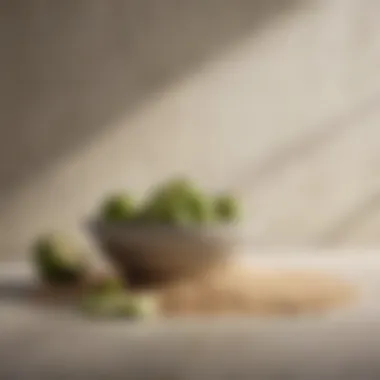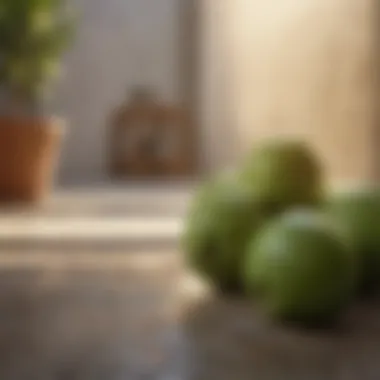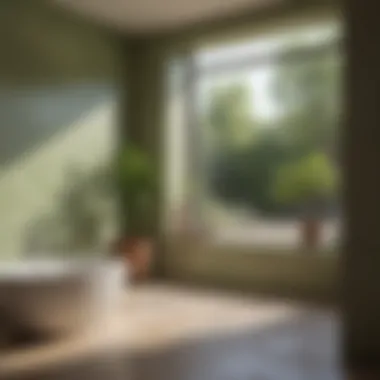Complete Guide on Making Lime Wash: Eco-Friendly Paint Recipe


Interior Design Tips
When it comes to interior design, incorporating eco-friendly and sustainable elements can elevate the aesthetic and promote a healthier living environment. Lime wash, a traditional paint made from natural lime and water, is a versatile choice for both interior and exterior surfaces. Drawing upon centuries-old techniques, lime wash adds a unique depth of color and texture to walls, ceilings, and other structures. Whether you are aiming for a rustic charm or a contemporary look, the transformative power of lime wash can redefine your living spaces.
Trendy Design Ideas
Incorporating lime wash into your interior design opens up a world of trendy possibilities. Embracing the trend of natural and raw finishes, lime wash imparts a subtle elegance and sophistication to any room. From accent walls to fireplace mantels, the soft matte finish of lime wash complements various design styles, including Scandinavian minimalism, bohemian chic, and industrial modern. By blending traditional techniques with modern aesthetics, lime wash offers a timeless appeal that transcends fleeting design fads.
Color Schemes and Combinations
When working with lime wash, the spectrum of color possibilities is endless. From classic whites and neutrals to bold earthy tones, lime wash can be customized to suit your preferred color scheme. Experimenting with different techniques such as color layering, aging, or limewash waxing can create unique textures and visual depth. Whether you opt for a monochromatic palette or a vibrant mix of hues, lime wash allows for versatility in color application, enabling you to tailor your interior design to reflect your personal style.
Furniture Arrangement Techniques
To complement the organic feel of lime wash, thoughtful furniture arrangement is key in enhancing the overall ambiance of a room. Embrace minimalist furniture pieces with clean lines and natural materials to harmonize with the earthy tones of lime wash. Incorporating elements like reclaimed wood, rattan accents, and indoor plants can further accentuate the eco-friendly aesthetic of lime wash. By carefully curating your furniture selection to align with the natural beauty of lime wash, you can create a cohesive and inviting living space that exudes comfort and style.
Introduction to Lime Wash
Lime wash, a traditional and eco-friendly paint choice, plays a significant role in the world of interior and exterior design. Its unique composition and timeless appeal make it a popular option among homeowners seeking a natural and sustainable alternative to conventional paints. As we delve into the intricacies of lime wash, we uncover the beauty of this ancient technique and its relevance in modern design trends. From its origins to its applications, this introductory section sets the stage for a comprehensive exploration of lime wash.
What is Lime Wash?
Origins and History
The origins and history of lime wash date back centuries, where it was utilized as a versatile paint in various cultures around the world. Its simple composition of lime, water, and pigments offers a glimpse into the craftsmanship of ancient artisans and their emphasis on natural, breathable finishes. The enduring popularity of lime wash stems from its ability to create a soft, matte patina that evolves over time, adding character and depth to surfaces. Its history as a durable, weather-resistant coating ensures its continued use in both traditional and contemporary settings.
Composition and Properties
The composition of lime wash consists of slaked lime, also known as lime putty, diluted in water to create a viscous mixture. This natural concoction allows for mineral-based pigments to be added for color variation, providing a sustainable alternative to synthetic dyes. The key properties of lime wash lie in its breathability, as it allows moisture to evaporate freely from underlying surfaces, preventing mold and mildew growth. Additionally, its high alkalinity offers antibacterial properties, making it a hygienic choice for interior and exterior applications.
Benefits of Using Lime Wash
Breathability and Durability
The breathability of lime wash stands out as a defining feature that sets it apart from conventional paints. Its porous nature enables walls to regulate moisture levels efficiently, creating a healthy indoor environment. This innate durability allows lime wash to withstand the test of time, developing a beautiful patina that enhances with age, rather than deteriorating like synthetic coatings.
Natural and Eco-Friendly
One of the main draws of lime wash is its eco-friendly composition, devoid of harsh chemicals that harm both the environment and occupants of a space. Being made from natural materials, lime wash is biodegradable, ensuring minimal ecological impact during production and application. Its low VOC content further contributes to improved indoor air quality, making it a conscious choice for sustainable living.
Antibacterial Properties
In addition to its aesthetic and environmental benefits, lime wash also boasts antibacterial properties that inhibit the growth of microbes on painted surfaces. This feature not only promotes a cleaner living environment but also reduces the need for frequent sanitization, making it an ideal choice for areas requiring high levels of hygiene, such as kitchens and bathrooms.
Applications of Lime Wash


Interior Walls
When applied to interior walls, lime wash imparts a soft, velvety texture that adds warmth and depth to living spaces. Its ability to regulate humidity levels makes it ideal for rooms prone to moisture, such as bathrooms and kitchens. The breathable nature of lime wash ensures walls remain dry and free from mold, promoting a healthier indoor environment.
Exterior Surfaces
Exterior surfaces benefit greatly from the protective properties of lime wash, which create a weather-resistant barrier against the elements. From historic buildings to modern facades, lime wash adds a touch of tradition and sophistication, enhancing curb appeal and longevity. Its self-healing properties ensure that minor imperfections blend seamlessly over time, maintaining the integrity of the painted surface.
Furniture and écor
Beyond walls and surfaces, lime wash finds application in furniture and decor items, lending a rustic charm to wooden pieces and accentuating their natural grain. From revitalizing antique furniture to creating artisanal finishes on contemporary pieces, lime wash offers endless possibilities for creative expression. Its versatility in adhering to various substrates makes it a favored choice among artisans and DIY enthusiasts.
Ingredients for Making Lime Wash
In this section of the comprehensive guide on how to make lime wash, we delve into the crucial aspect of understanding the ingredients necessary for creating this traditional and eco-friendly paint. The process of making lime wash relies on a few key components to ensure its effectiveness and longevity. By exploring the selection and significance of each ingredient, we can grasp the essence of this time-honored painting technique.
Key Components
Lime Putty
Lime putty stands out as a fundamental element in crafting lime wash. Its unique properties contribute significantly to the overall quality of the paint. Lime putty is known for its exceptional adhesion and breathability, making it an ideal choice for interior and exterior surfaces. The pliability and self-healing characteristics of lime putty make it a preferred option for achieving a smooth and durable finish. Although lime putty requires adequate curing time, its ability to resist cracking and weathering enhances its suitability for various applications.
Water
Water plays a crucial role in the formulation of lime wash, acting as a medium to achieve the desired consistency and texture. The quality and quantity of water used in the mixture directly impact the workability and final appearance of the paint. Maintaining the right balance of water ensures proper hydration of the lime putty and facilitates smooth application. Moreover, water aids in activating the chemical process of carbonation, allowing the lime wash to mature and attain its inherent properties over time.
Pigments (Optional)
While optional, pigments can add a decorative touch and enhance the visual appeal of lime wash. Incorporating pigments into the mixture allows for customization and color variation, enabling individuals to create unique finishes according to their preferences. However, it is essential to exercise caution when using pigments, as excessive amounts may affect the lime's properties and alter its breathability. By carefully measuring and gradually adding pigments, one can achieve a harmonious blend of color without compromising the integrity of the lime wash.
Choosing the Right Lime
When preparing lime wash, selecting the appropriate type of lime is crucial for achieving optimal results. Different types of lime possess varying characteristics that influence the final look and performance of the paint. Understanding the distinctions between these limes aids in making informed decisions regarding their suitability for specific projects.
Types of Lime
The choice between hydrated lime, hydraulic lime, and natural hydraulic lime determines the breathability, elasticity, and setting time of the paint. Hydrated lime offers high porosity and workability, making it suitable for interior surfaces. Hydraulic lime provides greater strength and water resistance, ideal for exterior applications. Natural hydraulic lime combines the advantages of both hydrated and hydraulic lime, offering a versatile option for diverse projects.
Sourcing High-Quality Lime
Obtaining lime from reputable sources ensures the purity and consistency of the material, essential for producing high-quality lime wash. High levels of impurities can compromise the paint's adhesion and durability, necessitating careful consideration when sourcing lime. Choosing lime from trusted suppliers with a reputation for supplying premium-grade products guarantees the success and longevity of the lime wash finish.
Preparing Lime Wash Mixture
In this article, the preparation of lime wash mixture holds paramount significance due to its intricate process and vital role in achieving the desired finish. When creating lime wash, meticulous attention to detail is crucial as each step impacts the final product's quality and appearance. Understanding the nuances of preparing lime wash mixture ensures that the paint adheres well to surfaces and maintains its authenticity.


Step-by-Step Guide
Mixing Lime Putty and Water
The process of mixing lime putty and water is a fundamental stage in creating lime wash. This step determines the paint's consistency and adhesion properties, essential for a durable finish. By blending lime putty and water thoroughly, a smooth and workable mixture is achieved, allowing for easy application and uniform coverage. The combination of these ingredients forms the base of lime wash, providing the necessary alkalinity for a chemical reaction that enhances its durability and breathability. Despite its straightforward nature, the correct ratio of lime putty to water is critical to achieving the desired texture and finish, showcasing the importance of precision in this process.
Adding Pigments
Introducing pigments to the lime wash mixture offers the opportunity to customize the paint's color, adding a unique aesthetic touch to surfaces. Pigments not only enhance the visual appeal of lime wash but also contribute to its UV resistance and durability. Careful consideration should be taken when selecting pigments to ensure compatibility with the lime mixture and desired hue intensity. By incorporating pigments thoughtfully, one can create a bespoke paint solution that harmonizes with the surrounding decor, elevating the overall ambiance.
Consistency and Texture
Achieving the optimal consistency and texture in lime wash is crucial for a successful application. The mixture should be smooth and free of lumps, allowing for easy spreading and blending on surfaces. Consistency impacts how well the paint adheres to walls or furniture, influencing its longevity and finish. Maintaining a balanced texture ensures uniform coverage and minimizes the risk of streaks or uneven drying. Striking the right balance between fluidity and thickness is key to producing a professional-looking result, underscoring the importance of paying close attention to the mixture's properties throughout the preparation process.
Safety Precautions
Protective Gear
The use of protective gear is imperative when working with lime wash to safeguard against potential skin and respiratory irritations. Gloves, goggles, and masks are essential in preventing direct contact with the paint mixture, which may contain caustic lime. Ensuring proper ventilation in the workspace further contributes to a safe environment, reducing the risk of inhaling harmful fumes. Prioritizing protective gear not only protects the person applying the lime wash but also promotes a secure and controlled working environment conducive to a successful painting project.
Ventilation
Maintaining adequate ventilation during the lime wash application process is crucial for dispersing fumes and promoting air circulation. Proper airflow helps to dissipate any odors from the paint mixture and minimize exposure to dust particles. Introducing cross ventilation by opening windows and utilizing fans aids in creating a conducive workspace with improved air quality. Ventilation also accelerates the drying process of lime wash, ensuring a quicker turnaround time for multiple coats or large surface areas. By prioritizing ventilation, one can enhance safety, comfort, and efficiency throughout the painting project.
Applying Lime Wash
When it comes to the application of lime wash, it plays a pivotal role in achieving the desired aesthetic and functional outcomes. The process of applying lime wash not only enhances the appearance of interior and exterior surfaces but also lends them durability and breathability. By exploring the topic of applying lime wash in this article, we aim to shed light on the significance of this technique in creating a distinctive finish that stands the test of time.
Tools and Techniques
Brushes, Sprayers, or Sponges
In the realm of lime wash application, the choice of tools such as brushes, sprayers, or sponges significantly influences the final result. Each tool brings a unique characteristic to the table, with brushes offering precision, sprayers ensuring uniform coverage, and sponges enabling creative textures. Understanding the role of these tools is essential for achieving the desired finish in line with the traditional charm of lime wash. The diversity in tools caters to different application preferences, making them indispensable in the lime wash process.
Brushing and Rolling Methods
The brushing and rolling methods constitute core techniques in the application of lime wash, dictating the final texture and coverage. Brushing allows for intricate detailing and artistic expression, while rolling provides a more consistent application over broader surfaces. Both methods contribute to the overall aesthetics and longevity of the lime wash finish, showcasing the versatility of this traditional painting approach. Selecting the appropriate method based on the intended outcome is crucial for a successful application process.
Layering and Blending
Layering and blending techniques hold the key to achieving depth and dimension in lime wash applications. These methods involve overlaying multiple coats of lime wash to create a rich, nuanced look that mimics the patina of aged surfaces. By mastering the art of layering and blending, individuals can customize the appearance of their walls or furniture, infusing them with character and sophistication. While these techniques offer extensive creative possibilities, they require precision and practice to execute effectively, underscoring the artistry behind lime wash applications.
Tips for a Professional Finish
Surface Preparation


The process of surface preparation sets the foundation for a flawless lime wash application, ensuring adhesion and longevity. Thoroughly cleaning and priming the surface, filling any imperfections, and creating a smooth base are critical steps in enhancing the paint's adherence and durability. Proper surface preparation paves the way for a professional-looking finish that not only elevates the aesthetics but also prolongs the lifespan of the lime wash.
Even Application
Achieving an even application of lime wash is essential for a cohesive and visually appealing outcome. Consistency in coverage prevents streaks or patches, delivering a seamless finish that highlights the inherent beauty of lime wash. Whether applying multiple coats or working on intricate details, maintaining uniformity in application safeguards against irregularities and ensures a harmonious appearance across the surface.
Curing and Sealing
The final stages of curing and sealing are crucial for enhancing the resilience and longevity of lime wash surfaces. Allowing the lime wash to cure properly enables it to harden and adhere securely to the surface, increasing its resistance to wear and tear. Sealing the lime wash with an appropriate finish further fortifies its protection against moisture and stains, preserving the beauty of the painted surface for years to come. By prioritizing proper curing and sealing techniques, individuals can safeguard their investment in a timeless and eco-friendly paint choice.
Caring for Lime Wash Surfaces
This section delves into the vital aspect of maintaining and preserving lime wash surfaces to ensure their longevity and visual appeal. Proper care not only enhances the aesthetic charm but also extends the durability of the finish, making it a worthy investment. Regular maintenance practices are crucial to prevent wear and tear, keeping the surfaces looking fresh and vibrant.
Maintenance Practices
Cleaning and Washing:
Cleaning and washing are fundamental maintenance steps that play a pivotal role in sustaining lime wash surfaces. By using a mild, non-abrasive cleaner and soft cloth, homeowners can gently remove dust, dirt, and grime without damaging the paint's delicate patina. This practice not only maintains the luster of the surface but also promotes a healthy environment by eliminating allergens.
Touch-ups and Repairs:
Addressing minor damages promptly through touch-ups and repairs is essential for preserving the integrity of lime wash surfaces. Whether treating small scratches, cracks, or discolorations, a meticulous approach using matching lime wash mixture ensures seamless blending and restoration. Regular inspections and touch-up sessions prevent minor issues from escalating, resulting in a polished and flawless finish.
Enhancing Longevity
Protective Coatings:
Applying protective coatings is a strategic measure to enhance the longevity of lime wash surfaces, shielding them from environmental factors and enhancing resistance to daily wear. Various options such as beeswax or specialized lime wash sealants provide an added layer of defense against moisture, stains, and UV exposure. These coatings not only fortify the surface but also accentuate the natural beauty of the lime wash, imparting a subtle sheen.
Avoiding Harsh Chemicals:
Avoiding harsh chemicals in cleaning products and maintenance routines is paramount to preserving the authenticity and vitality of lime wash surfaces. Abrasive substances can erode the lime wash finish, leading to discoloration and degradation over time. Opting for gentle, eco-friendly solutions not only safeguards the paint but also aligns with the eco-conscious ethos of lime wash, ensuring a sustainable and eco-friendly maintenance approach.
Conclusion
In wrapping up this comprehensive guide on making lime wash, it is crucial to understand the significance of this traditional and eco-friendly paint choice. Lime wash offers a unique blend of benefits that set it apart from conventional paints. Its breathable and durable nature ensures longevity, making it an ideal option for both interior and exterior surfaces. The natural and eco-friendly composition of lime wash not only contributes to a healthier living environment but also showcases a commitment to sustainable practices. Additionally, the antibacterial properties inherent in lime wash make it a practical choice for spaces where hygiene is a priority. By considering these aspects, one can appreciate the multifaceted appeal of lime wash and its timeless allure.
Final Thoughts on Lime Wash
Timeless Appeal
Delving into the timeless appeal of lime wash reveals a feature that adds to its charm among painting options. The weathered look attained over time with lime wash contributes to its timeless aesthetic. This aged appearance not only adds character to surfaces but also offers a sense of history and personality to the space. Homeowners seeking a classic and elegant ambiance often opt for lime wash due to its ability to evoke a sense of tradition and longevity. Despite its deliberate weathering process, the timeless appeal of lime wash is unmatched, making it a desirable choice for those looking to infuse a touch of heritage into their living spaces.
Sustainable Choice
Exploring the sustainable aspects of lime wash sheds light on its environmental impact and long-term benefits. As a sustainable choice, lime wash boasts a natural composition that aligns with eco-conscious practices. The lime-based formula is free from harsh chemicals, making it a safe and eco-friendly option for environmentally-aware individuals. Not only does lime wash reduce the carbon footprint of paint products, but it also promotes a healthier indoor environment by minimizing the release of harmful toxins. Embracing lime wash as a sustainable choice not only benefits the planet but also reflects a commitment to responsible living and design.
Artistic Possibilities
Unveiling the artistic possibilities of lime wash underscores the creative potential this paint offers. The unique application techniques associated with lime wash allow for artistic expression and customization. From textured finishes to color variations, lime wash provides a versatile canvas for creative experimentation in interior design. By embracing the artistry of lime wash, individuals can craft visually captivating spaces that exude originality and depth. The malleability of lime wash as a medium opens up a world of artistic exploration, enabling homeowners to transform their living environments into personalized works of art.







